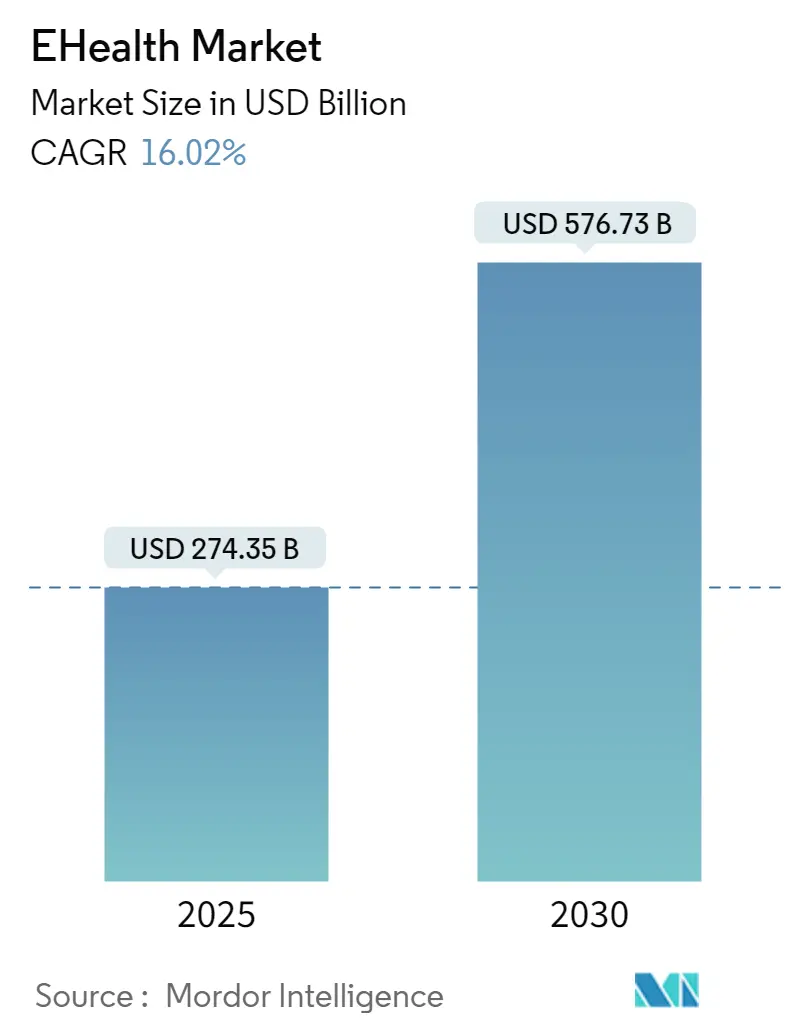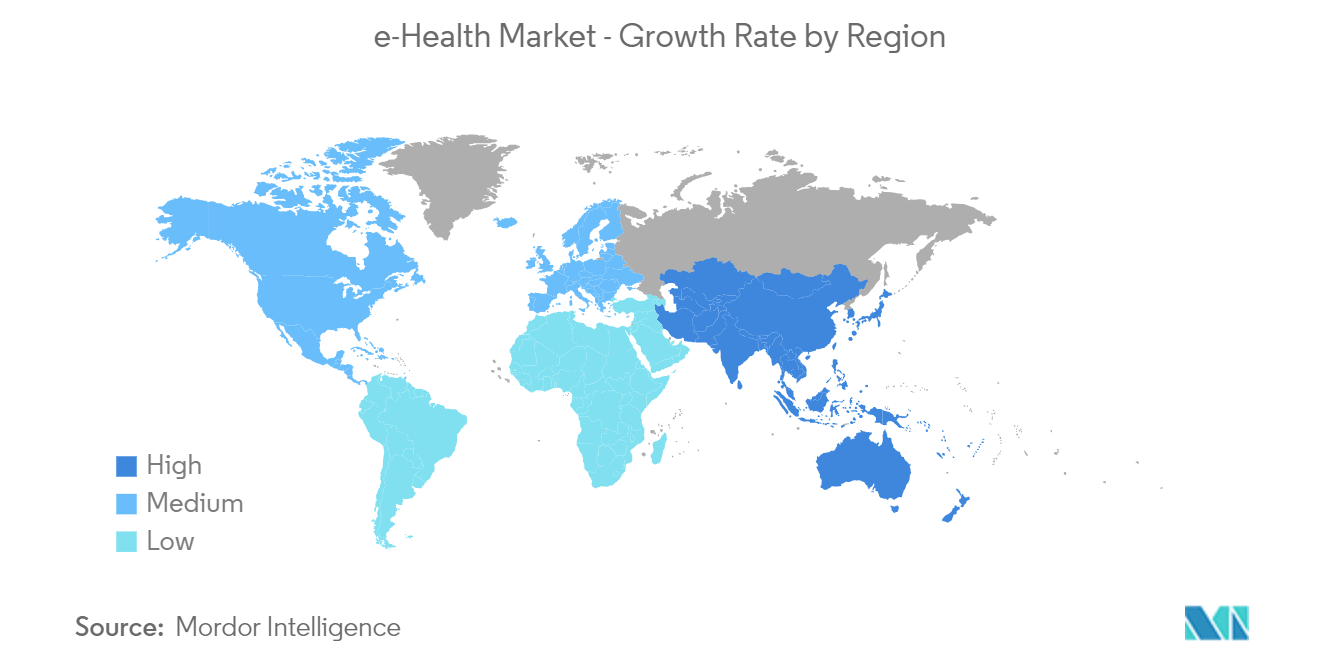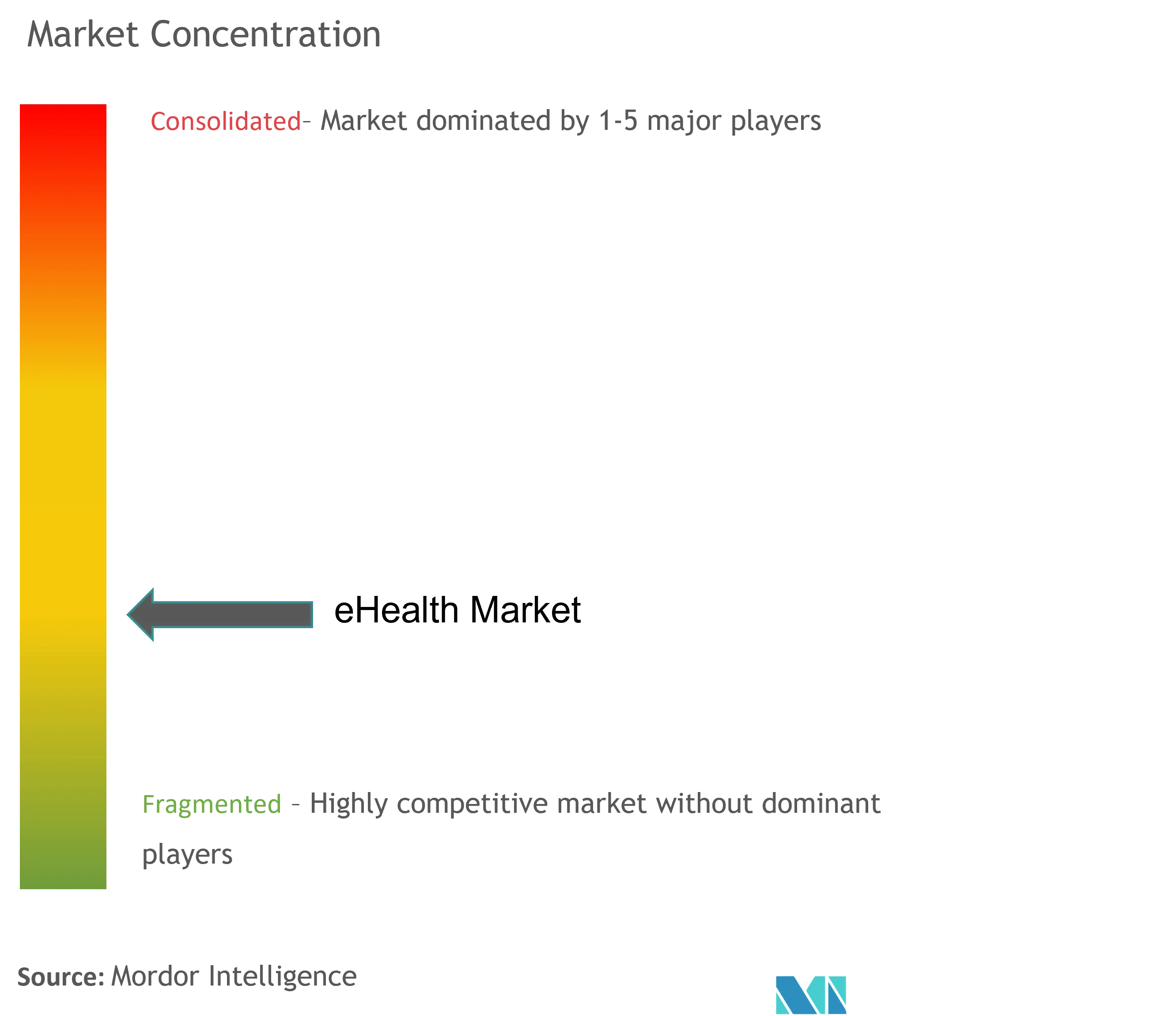
| Study Period | 2019 - 2030 |
| Market Size (2025) | USD 274.35 Billion |
| Market Size (2030) | USD 576.73 Billion |
| CAGR (2025 - 2030) | 16.02 % |
| Fastest Growing Market | Asia Pacific |
| Largest Market | North America |
| Market Concentration | Medium |
Major Players
*Disclaimer: Major Players sorted in no particular order |
eHealth Market Analysis
The EHealth Market size is estimated at USD 274.35 billion in 2025, and is expected to reach USD 576.73 billion by 2030, at a CAGR of 16.02% during the forecast period (2025-2030).
The propelling factors for the growth of the e-health market are the growth in IoT and technological innovations, rising preference toward mobile technology and the internet, and rising demand for population health management.
The increasing adoption of digital health systems is expected to drive the market during the forecast period. For instance, according to an article published in Digital Health in August 2022, the digital health transition in numerous healthcare facilities throughout Saudi Arabia was assessed utilizing digital health indicators. The total digital transformation score in private healthcare facilities was observed to be higher than in governmental hospitals due to greater implementation rates. Thus, the high adoption of digital health systems across private healthcare facilities is expected to increase market growth during the forecast period.
Government initiatives to increase the preference for mobile technology and the internet are expected to propel market growth. For instance, in May 2022, Israel approved 19 initiatives for USD 30 million for a new digital health initiative enabling healthcare institutions, including HMOs, hospitals, and institutes, to develop the digital infrastructure needed for collaborative R&D projects with startups in the field of healthcare.
The technological advancement in e-health solutions, product launches, and partnerships by market players is expected to propel market growth during the forecast period. For instance, in May 2022, Brazil's digital health company, Memed, launched a set of digitally integrated care pathways that allow patients to purchase medication online directly from a Memed e-prescription.
Similarly, in January 2022, Visionflex partnered with MediRecords, Australia's cloud-based electronic medical record and practice management systems provider. The partnership is aimed to integrate Visionflex's video conferencing platform, Vision, with MediRecords' cloud-based electronic health record and practice management software platforms.
Therefore, the market is anticipated to grow during the forecast period due to rising launches, partnerships, and fundraising for market players' expansions of eHealth solutions. However, the concerns over data security, the lack of reimbursement policies in emerging markets, and the lack of proper infrastructure for eHealth in emerging markets are estimated to restrain the market growth.
eHealth Market Trends
The e-Prescribing Segment is Expected to Hold a Significant Market Share During the Forecast Period
E-prescribing or electronic prescribing is a technology framework that allows physicians and other medical practitioners to write and send prescriptions to a participating pharmacy in an electronic format instead of using written prescriptions.
The segment is expected to grow during the forecast period owing to the rising demand for e-prescriptions due to the minimization of prescription errors, cost reduction, and increasing technological advancements and launches by market players. For instance, according to an article published in the British Medical Journal in December 2022, adverse drug events and medication errors are common among the aging population in nursing homes in Japan. The rising focus on reducing the abuse of controlled substances and increasing focus on reducing medical errors will accelerate the adoption of an e-prescribing system during the forecast period.
Also, the rising government initiatives leading to an increase in the utility of e-prescription are significantly adding to the segment's growth. For instance, in August 2022, the Japanese Ministry of Health, Labour, and Welfare selected four pilot sites for its electronic prescription project. This came ahead of the formal launch of e-prescriptions across the country in January 2023.
Similarly, in November 2022, an official agreement was reached between the Mexican Hospital Consortium (CMH), TINC, and the Association for the Advancement of Medical Instrumentation (AAMI), establishing a new Alliance for Healthcare Technology Management (HTM) in Mexico. Hence, such government initiatives are expected to drive the market during the forecast period.
Moreover, the strategic initiatives by market players for expansions of e-prescription solutions are expected to propel the segment's growth. For instance, in January 2023, the Qatar-based HealthTech startup At Home Doc raised USD 1.9 million in Pre-Series A funding led by Elaj Group's investment arm Tawasol Holdings, endorsed by Qatar Development Bank (QDB) and other angel investors. In June 2022, the Hamad Medical Corporation (HMC) and Primary Health Care Corporation (PHCC) announced adopting Cerner-managed technology to deliver better outcomes in Qatar. The funding will be utilized to enhance electronic prescription solutions in the country.
Thus, the market segment is expected to witness significant growth during the forecast period due to the above-mentioned factors.

North American Holds the Significant Market Share and is Expected to Follow the Same Trend During the Forecast Period
The rising focus on patient care and need, supported by the well-developed and technologically advanced healthcare system, the increasing demand for more effective data management systems, and increasing government investments, acquisitions, and product launches in the region are expected to drive the growth of the eHealth market in the region.
The increasing government investments are expected to drive the market during the forecast period. For instance, in February 2022, the Department of Health and Human Services (HHS), through the Health Resources and Services Administration (HRSA), awarded nearly USD 55 million to 29 HRSA-funded health centers to increase healthcare access and quality for underserved populations through virtual care such as telehealth, remote patient monitoring, digital patient tools, and health information technology platforms. Hence, such investments in digital health are expected to drive the market during the forecast period.
Also, the rising launches, partnerships, and increasing adoption of electronic health solutions in the region are expected to propel the market growth. For instance, in March 2022, Cantata Health Solutions reported that the Village Network would deploy its Arize Electronic Health Record (EHR) to leverage its superior configuration, outcomes-based reporting, and mobile access capabilities. In May 2022, Cantata Health Solutions was selected by Mental Health Resources (MHR) in New Mexico as its technology partner and will deploy the Arize Electronic Health Record (EHR) solution.
Additionally, in January 2024, Eli Lilly and Company launched LillyDirect, a new digital healthcare experience for patients in the United States living with obesity, migraine, and diabetes. LillyDirect offers disease management resources, including access to independent healthcare providers, tailored support, and direct home delivery of select Lilly medicines through third-party pharmacy dispensing services. Hence, the launch of such eHealth platforms in the United States is expected to drive the market during the forecast period.

eHealth Industry Overview
The eHealth market is fragmented in nature due to the presence of several companies operating globally and regionally. The competitive landscape includes an analysis of a few international and local companies with major or significant market shares. Some of the key market players are Boston Scientific Corporation, Veradigm LLC, Oracle Cerner, Athenahealth Inc., GE Healthcare, CompuMed Inc., Epic Systems Corporation, Optum Health, Siemens Healthineers, and Koninklijke Philips NV, and eClinicalWorks.
eHealth Market Leaders
-
athenahealth Inc.
-
Boston Scientific Corporation
-
CompuMed Inc.
-
Veradigm LLC
-
Oracle Cerner
- *Disclaimer: Major Players sorted in no particular order

eHealth Market News
- April 2024: eHealth Inc., a private online health insurance company, launched the eHealth Perks rewards program. The company has already enrolled over 200,000 existing eHealth Medicare customers in perks.
- January 2024: The Republic of Mauritius launched the One Patient, One Record project in Port-Louis. The "One Patient, One Record" initiative aims to leverage state-of-the-art technology, facilitating a shift to a more cost-efficient, patient-centric, and accountable system for managing patient records, details, and test results.
eHealth Industry Segmentation
As per the scope of the report, eHealth is the use of modern electronic information and communication technologies to deliver healthcare when healthcare providers and patients are not in direct contact, and their interaction is mediated by electronic means. The eHealth market is segmented by component, type of service, end user, and geography. By component, the market is segmented into electronic health records, e-prescribing, clinical decision support systems, telemedicine, and other components. By type of service, the market is segmented into monitoring services, diagnosis services, and other types of services. By end user, the market is segmented into hospitals, insurance companies, and other end users. By geography, the market is segmented into North America, Europe, Asia-Pacific, the Middle East and Africa, and South America. The market report also covers the estimated market sizes and trends for 17 countries across major regions globally. The report offers the value (in USD) for the above segments.
| By Component | Electronic Health Records | ||
| e-Prescribing | |||
| Clinical Decision Support Systems | |||
| Telemedicine | |||
| Other Components | |||
| By Type of Service | Monitoring Service | ||
| Diagnosis Service | |||
| Therapeutic and Other Services | |||
| By End User | Hospitals | ||
| Insurance Companies | |||
| Other End Users | |||
| Geography | North America | United States | |
| Canada | |||
| Mexico | |||
| Europe | United Kingdom | ||
| Germany | |||
| France | |||
| Italy | |||
| Spain | |||
| Rest of Europe | |||
| Asia-Pacific | China | ||
| Japan | |||
| India | |||
| Australia | |||
| South Korea | |||
| Rest of Asia-Pacific | |||
| Middle East and Africa | GCC | ||
| South Africa | |||
| Rest of Middle East and Africa | |||
| South America | Brazil | ||
| Argentina | |||
| Rest of South America | |||
eHealth Market Research FAQs
How big is the EHealth Market?
The EHealth Market size is expected to reach USD 274.35 billion in 2025 and grow at a CAGR of 16.02% to reach USD 576.73 billion by 2030.
What is the current EHealth Market size?
In 2025, the EHealth Market size is expected to reach USD 274.35 billion.
Who are the key players in EHealth Market?
athenahealth Inc., Boston Scientific Corporation, CompuMed Inc., Veradigm LLC and Oracle Cerner are the major companies operating in the EHealth Market.
Which is the fastest growing region in EHealth Market?
Asia Pacific is estimated to grow at the highest CAGR over the forecast period (2025-2030).
Which region has the biggest share in EHealth Market?
In 2025, the North America accounts for the largest market share in EHealth Market.
What years does this EHealth Market cover, and what was the market size in 2024?
In 2024, the EHealth Market size was estimated at USD 230.40 billion. The report covers the EHealth Market historical market size for years: 2019, 2020, 2021, 2022, 2023 and 2024. The report also forecasts the EHealth Market size for years: 2025, 2026, 2027, 2028, 2029 and 2030.
Our Best Selling Reports
eHealth Industry Report
Statistics for the 2025 EHealth market share, size and revenue growth rate, created by Mordor Intelligence™ Industry Reports. EHealth analysis includes a market forecast outlook for 2025 to 2030 and historical overview. Get a sample of this industry analysis as a free report PDF download.




